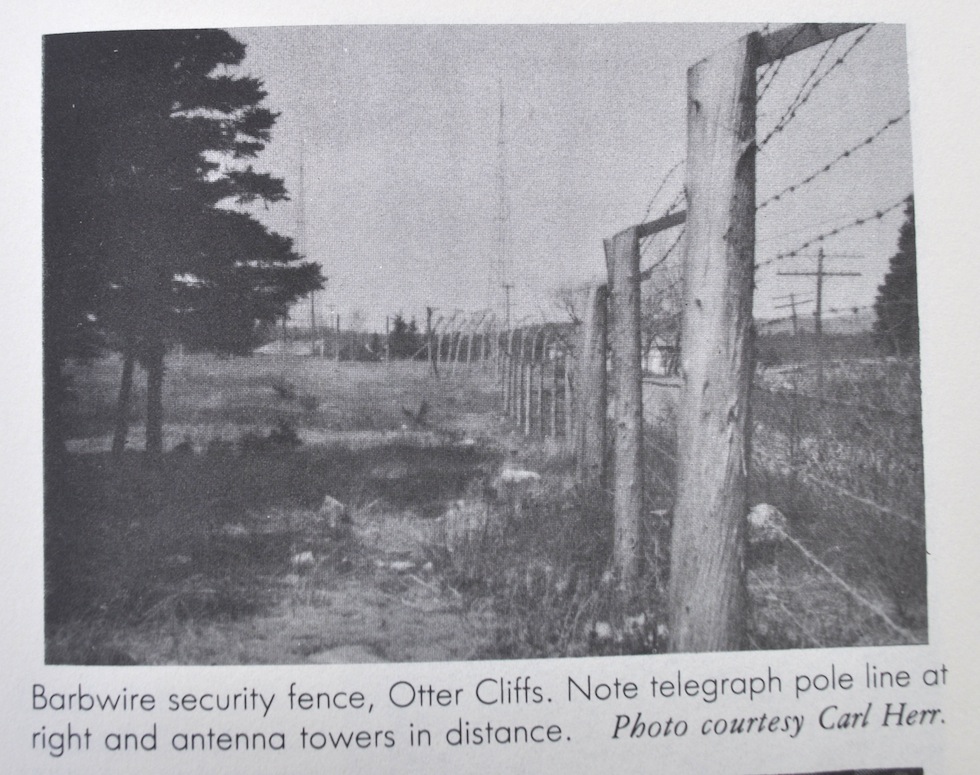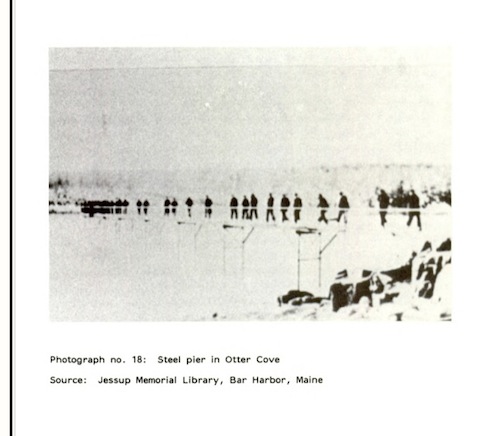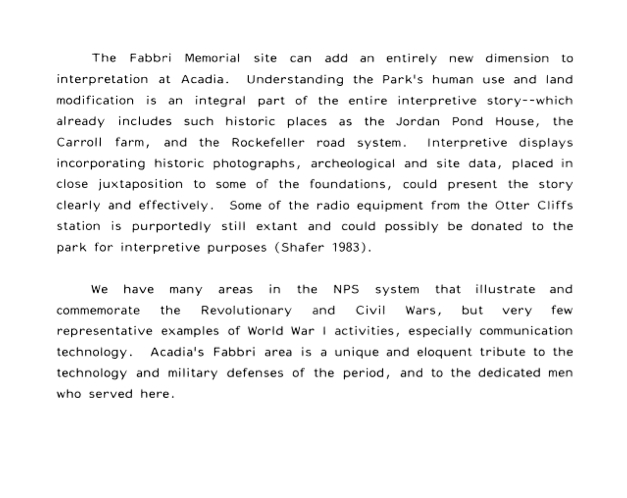Food, language, gardening, people, wildlife, history—the world is so full of wonder. My life skitters between them all, lacking focus perhaps, but never dull. Heading home to weed, a quick stop to chat with a neighbor set me off instead in pursuit of a watchtower.
 Otter Creek once had a state-of-the art World War I communication station. There is a commemorative plaque, and Acadia National Park has built a picnic area there. Near this is a hard-to-find road that starts wide and lined with regularly spaced trees but which then disappears into brush and becomes impassable. A rough wooden sign, slowly being absorbed by the tree it is mounted on, points the way to this road and reads To Otter Cliffs.
Otter Creek once had a state-of-the art World War I communication station. There is a commemorative plaque, and Acadia National Park has built a picnic area there. Near this is a hard-to-find road that starts wide and lined with regularly spaced trees but which then disappears into brush and becomes impassable. A rough wooden sign, slowly being absorbed by the tree it is mounted on, points the way to this road and reads To Otter Cliffs.
I knew all this, and had read about Alessandro Fabbri who was the determined and driving force behind the establishment of what is called The Fabulous Radio NBD. I had followed that road, thinking it led to the site of the radio station, but when it dead-ended in a small overgrown clearing, I guessed all signs of the station were long gone.
Otter Creekers love their history, and my neighbor Paul Richardson has devoted much of his life to recording it. I’d been making a map of our village, and wanted him to see if it was accurate. I spotted him at his greenhouse on the way home from work and stopped to have him look at it. “Oh, yes,” he said, in his unhurried voice with its soft suggestion of Maine accent, “Very good, except this road which you say ends at the radio station. That was the road to the watchtower.”
Watchtower? I may have heard of it, but sloppily let it slide from my memory. Paul’s finger traced the road I have walked, snow-shoed, and shared with friends, just to show them the row of trees in the middle of nowhere and the ancient wooden sign.
“Was there anything left of the tower?” I asked. Paul said it had been years since he was there, but that there had been an old foundation. I explained how the road became impossible to follow, hoping for clues to find the watchtower site. “Oh, you don’t need to follow the road. You can get to the lookout just off the parking lot the Park put in.” Was it possible the remains of an old tower were so close by and I had never known? I was ready to explore, so dashed home, changed into explore clothes and got husband Dennis to join the search. He has lived here all his life, had never heard of the tower, and does not remember his dad mentioning it. I said Paul told me exactly where to go, and we would find it.
I was ramped up and positive, Dennis a bit more skeptical. We parked in the lot we have used many times, the parking lot for the path along the cliffs. This time we went in the opposite direction, and found the ground rose steeply. The rocks were covered in fern and moss, and the late day sun filtered through. We looked up the high, rocky outcrop and started our scrambled ascent. The light made the greens vivid, and the tree trunks seemed black, still wet with the morning’s rain. It was new terrain, and even without finding where the tower had been we already felt satisfied with discovery. We pulled ourselves up to the top of the ledge. The trees surrounding the parking lot have grown tall, but it was still obvious this was a high point. This point is 188 feet above sea level. There were views over Otter Cove, of Champlain Mountain, and out towards open ocean. Once we tore our eyes away from the view and looked down it took barely a minute to spot an iron eyebolt and then the concrete blocks that were once part of the tower’s foundation.
We tried to find this end of the wide, tree-lined road we were familiar from the Miller Garden Road, but that will have to wait for another day. We did find broken glass and bits of burnt coal, presumably from the coal stoves the watchers at the tower used to keep warm. There was no doubt, we were there, and we had found the remains of the tower.
Back home I pulled out my history of the radio station and found the dimly remembered photos of the tower. It was built in 1918 with funding from Alessandro Fabbri’s brother Egisto. Fabbri was awarded the Navy Cross for developing the radio receiving station, which was the sole receiving station for European communications.
Brandon Wentworth, radio-communications enthusiast and historian, wrote The Fabulous Radio NBD in 1984. Well-researched and the source of many of the historic photos shared here, it tells the history of Alessandro Fabbri, the Otter Cliff radio station, and the local men who worked there. My husband’s grandfather was one of them. He had enlisted, expecting to be sent overseas, and instead was stationed right here at the radio station which at one point employed over 200 men. And yet no one in the family remembers hearing of the tower. After the war was over the tower was used as a radio compass station, and is credited with saving more than one ship from going aground. It was razed in 1935 for the construction of the Park Loop Road, although the foundations are quite distant from the roadbed.
When the Park Loop Road was constructed, a memorial to Alessandro Fabbri was placed in 1939, and is there today. In the eighties the Park planned on expanding the area for parking and picnicking. Diane Lee Rhodes was hired to assess the site. She wrote Archeological Investigations at Fabbri Memorial in 1983.
This in-depth study has photos of the station and the tower, and concludes with the recommendation that the site should be preserved.
Diane wrote, “We have many areas in the NPS system that illustrate and commemorate the Revolutionary and Civil Wars, but very few representative examples of World War I activities, especially communication technology. Acadia’s Fabbri area is a unique and eloquent tribute to the technology and military defenses of the period, and to the dedicated men who served here,” and “The Fabbri Memorial site can add an entirely new dimension to interpretation at Acadia.”
In spite of the report’s recommendations, stone steps, barrack walls, foundations, and water tower footings were all eradicated in the 1980’s for picnic tables and comfort stations. It is a delightful place for lunch, and I, and many bikers and hikers, are grateful for the toilets, and yet I wish history could have been honored. It would have made the picnic spot a richer place, and my husband’s grandchildren would be able to say, “The lookout tower? Oh yes, I know where it was, my great -great grandfather was stationed there.”





